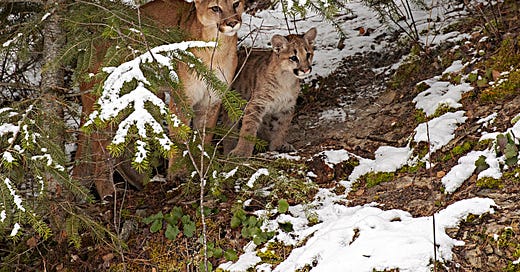Time to Stop Hunting America’s Lion
Note: I wrote about this campaign last month on Substack. This is a reworked version that went to editorial page editors this month.
Prior to the arrival of Europeans to America and the rapid expansion of human population from East to West coasts, the adaptable cougar – aka the mountain lion, catamount, panther or puma – lived throughout the area, ranging from North to South America, living in deserts, forests, mountains and wetlands.
The push that started more than 250 years ago to “settle” America meant taming the wild, and that included the cougar, feared and hunted aggressively in every area that ultimately formed the United States, so much so that the animal was wiped out east of the Mississippi, except for an isolated population in Florida.
Today, cougars only live in 16 of our 48 contiguous states, and their population is estimated to be under 30,000. Thirteen of those states classify cougars as a game species and allow them to be hunted, according to The Cougar Fund. That includes Colorado. The Mountain Lion Foundation estimates that the cougar population in Colorado is between 3,800 and 4,400. In 2022, The Denver Post reported that from 2019 to 2021, an average of 516 mountain lions were killed each year. This season, Colorado issued 2,500 licenses to kill cougars.
Hunters are allowed to use dog packs, often outfitted with telemetry equipment, to chase, stress and terrorize the big cats who may suffer for minutes or maybe for hours. In this inhumane and unsportsmanlike hunt, the mountain lion may ultimately seek refuge in a tree where, defenseless, the lion is shot dead and falls to the ground.
“That is the moral and sporting equivalent of shooting an animal in a cage at a zoo,” said Wayne Pacelle, founder of Animal Wellness Action. “It defies any commonsense notion of fair chase and sportsmanship, and it is more an execution than it is a hunt. It’s cruelty to animals, which just happens to have the sanction of the state.”
Cats Aren’t Trophies is a group that has launched a petition drive in Colorado to collect signatures for a November ballot measure that would ban trophy hunting of mountain lions. To make the ballot, 125,000 registered voters need to sign the petition by July 5.
The Denver Post also reported that about 1,300 bobcats were killed in 2018 and 2019. There is no limit on killing bobcats. Cats Aren’t Trophies also seeks an end to trapping of bobcats for their fur in the ballot measure it hopes Coloradoans will support. Lynx, extirpated in Colorado by hunting, trapping and other exploitation, were reintroduced in the state in 1999, with 41 animals brought from Alaska and Canada. While lynx are protected under the Endangered Species Act, traps do not distinguish between animals that are protected by law and those who aren’t. So the ballot measure, if passed, would also be extremely important for lynx.
“Lynx, a close relative to bobcats, are naturally attracted to bait set for bobcats and are harmed, injured or killed when caught in traps,” said Christine Capaldo, a veterinarian in Southwestern Colorado. “Trapping bobcats causes unnecessary pain and suffering to the target animal and also to nontarget animals that include lynx.”
“This ballot measure is the only way to bring an end to this,” said Pat Craig, founder of the Wild Animal Sanctuary in Keenesburg, Colo. “We can change this course.”
Mountain lions are essential animals to healthy ecosystems. These eco engineers keep deer and elk populations in check, limiting their negative impacts on forests and reducing chronic wasting disease in these two animal populations. The mountain lion is an amazing apex species that lives among us without any consequential impact, and it’s rare that a mountain lion kills a human.
Bobcats face additional risks, as they are trapped for commercial exploitation, explained Pacelle. Even if a trapper checks the trap every 24 hours, the frightened animal struggles to free itself. Once the trapper returns to the trap, he either bludgeons or stomps the bobcat to death. There is no market in the U.S. for bobcat pelts, which are sold to foreign countries, mainly China.
Cats Aren’t Trophies has taken a bold stance for animal rights in its work to get this issue on the ballot in November, one that California addressed in the past. California ended mountain lion hunting in 1972 and bobcat hunting in 2020. As well, the California Department of Fish and Wildlife has studied the state’s mountain lions for more than 40 years and created a conservation program in 2015 for research and monitoring, conflict resolution and to inform habitat conservation and protection. Other states, even where mountain lions have not re-established populations, should consider following suit. Texas, on the opposite end on cougar care, has virtually no protections for mountain lions.
America’s days of taming the wild are behind us. We’re behind in rewilding. Securing the safety and future for America’s lion across the country would be a good start.
For information about the citizen initiative in Colorado, visit Cats Aren’t Trophies.
Maria Fotopoulos writes about the connection between overpopulation and biodiversity loss, and from time to time other topics that confound her. On FB @BetheChangeforAnimals.







